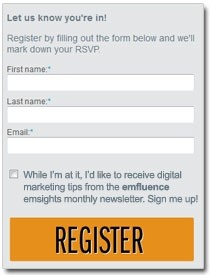It’s an ongoing discussion in the email marketing world: Do you choose to grow your list via opt-in vs. opt-out methods? I had a client ask me this week what were the real pros and cons of each. How could they decide what’s right for them?
First, what’s the difference?
What is opt-in vs opt-out?
Opting-in means that a user will first need to check a box (or take a confirmative action) to consent. While opting-out means a user must uncheck a box to remove their consent.
 What is an opt-in email sign-up?
What is an opt-in email sign-up?
Opting-in means that a user will first need to check a box, or take a confirmative action, to consent.
Your email sign-up form’s only function is to subscribe someone to your email list,
or…
You include an email sign-up checkbox on a registration or checkout form, it’s unchecked by default.
What is an opt-out email sign-up?
Opting-out means that a user must uncheck a box to remove their consent.
You pre-check that email signup checkbox on the registration/checkout form,
or…
You add every email address you capture via registration/check-out. For this method, you’re basically assuming that those who don’t want it will opt-out when they get their first email.
How to Build a Newsletter Opt-In Welcome Series
Opt-In or Opt-Out: Which is Better?
I typically err on the side of caution and recommend the opt-in method. It requires an active choice by your new subscriber and therefore makes them more likely to engage with your emails than subscribers who didn’t actively subscribe.
Pros of the Opt-Out Method
But if you’re considering opt-out methods of subscriber acquisition, here’s the good news:
- It’s not illegal to pre-check the checkbox. CAN-SPAM law says that you can email anyone you want until they tell you to stop (i.e. Unsubscribe).
- Depending on the form (i.e. shopping cart checkout vs. a white paper download vs. a partner sign-up form), people may *expect* to be signed up for email automatically or at least won’t be surprised to see it when you send your first email.
- You’ll definitely grow your list at a faster rate by pre-checking the box for customers/prospects.
Cons of the Opt-Out Method
But, opt-out email subscription will degrade the quality of your email list and can hurt your ROI:
- People who don’t pay attention and don’t un-check may not realize they’re being signed up for emails and may be either surprised to see it or else will find it irrelevant or unwanted. This means they may be more likely to mark you as Spam. (Again, depends on your form!)
- As you add email addresses, not everyone will be interested and more likely you’ll have some email addresses that aren’t the “primary” address. For example, I checkout on eCommerce websites using my Hotmail address, so in case I get auto-signed up for things it doesn’t clog up my “real” inbox at Gmail. Studies show I’m not alone in this tactic. Inactive recipients that rarely/never see your emails drive your response rates percentages down, which Yahoo!, Gmail, Hotmail and others take note of. For example:
- If you’re sending to 10,000 and 2,000 are interacting, you have a 20% engagement (pretty standard)
- If you’re sending to 40,000 and 3,000 are interacting, you have a 7.5% engagement (abysmal). This flags you as a potential un-wanted or potentially a spammer… this means less inbox placement (which means lower response rates … vicious cycle)
Bottom line: The ROI of adding a large number of new subscribers if only a few of them are engaged is pretty low. And it means you’re spending more money on email marketing volume to people that aren’t taking the actions you want them to (open, click, buy). Here’s a great blog to check out on the importance of keeping a smaller, more engaged email list in order to increase ROI.
Email Opt-In and Opt-Out Laws
Depending on where your subscriber base resides, you should be taking laws like GDPR and CCPA into consideration. Here’s a high-level overview of what each law might mean for your opt-in or opt-out strategy:
GDPR
The original “right to be forgotten” law, GDPR lays out a set of rules designed to protect personal data and privacy for citizens of the European Union. Any organization operating within the EU (or sending emails to EU citizens) must adhere to strict conditions when collecting personal data, and must also protect that data from theft, exploitation, and abuse. For email marketers, emailing people without their knowledge of how you obtained their information and their expressed permission to send them emails is a big problem. Learn more about GDPR here.
CCPA
Think of the California Consumer Protection Act (CCPA) as GDPR come state-side. The California law protects the consumer privacy of California residents and affects every major corporation who collects data on California citizens. In its current form, the law affects only businesses that earn $50 million in revenue; sell 100,000 consumer records each year or derive 50% of their annual revenue from selling data. Like GDPR, sending emails to people who a) don’t know who you are and b) didn’t give you permission to email them amounts to major problems. Learn more about CCPA here.
Still think opt-out is best for you? No problem… we’ve seen it work! One of our eCommerce clients just switched from unchecked to pre-checked boxes on their shopping cart checkout forms. The people that buy from them want to hear from them! This particular client hasn’t seen a huge uptick in complaints or unsubscribes, so it’s definitely possible to be successful with those pre-checked boxes. Just keep an eye on bounces, suppressions and spam complaints. And of course, watch your overall response rate: if your conversion rates start to suffer, you may be having some issues getting into the inbox and it’s time to talk about cleaning up that list.
Are you ready to start growing your email lists? Talk to an emfluence pro about how to grow your list the right way or find us on Twitter @emfluence and tell us your thoughts on opt-in vs. opt-out for email list growth.
Ready to get started?
 What is an opt-in email sign-up?
What is an opt-in email sign-up?


Great comparison I must say! I also think that the biggest upside of an email opt-out list is that it can grow very quickly which can also increase the number of spam complaints that we receive when we send emails.
Hello I have a question about this. Everytime I buy something online (say from GAP or some other online retailer) I uncheck the opt in to receive promos/offers/mailing list as I’m checking out with my cart. Yet, without fail I always get subscribed with weeks of emails before I bother to take the time of unsubscribing. What is happening here? Shouldn’t my uncheck action (my opt out) be applied?
Hi Zoe,
Great question! Opt in is definitely the preferred method of subscribing, but there are plenty of brands that do more of a forced opt in (like you’ve described). Your unchecked action should apply, but the more reliable route would be to officially “unsubscribe” using their link. That tends to reset the status of your record, whereas a checkbox would simply not opt you in to anything.
-Natalie